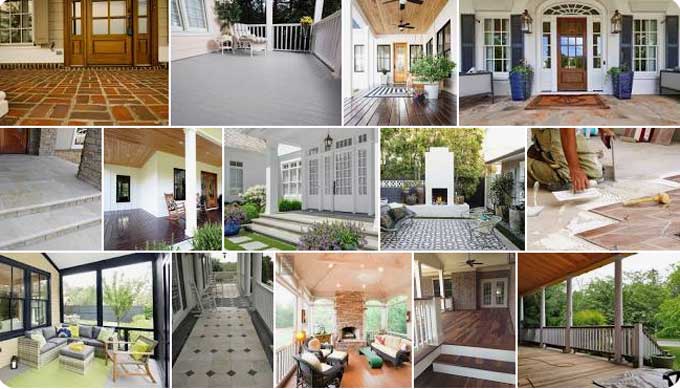
Everything You Need to Know About Porch flooring for your house

What do you mean by Porch Flooring in Construction?
Porch flooring refers to the material or surface installed on a porch or outdoor living space floor. The porch is typically an outdoor area that is covered and attached to a house, often at the front or back of the house.
Porch flooring can be made from a variety of materials such as wood, composite decking, vinyl, concrete, tile, or natural stone. The choice of material will depend on factors such as the climate, design preferences, and maintenance requirements.
Porch flooring can also be designed in different styles and patterns, such as diagonal, herringbone, or basket weave. This can add visual interest to the porch and enhance its overall aesthetic appeal.
What are the different types of Porch Flooring used in homes?
There are several types of porch flooring materials commonly used in homes. The following are some of the most popular types:
1. Wood: Wood is a popular choice for porch flooring due to its natural beauty and durability. Common types of wood used for porch flooring include cedar, mahogany, and redwood.
2. Composite: Composite porch flooring is made from a combination of wood fibres and plastic. It offers the look of wood without the maintenance, as it does not need to be stained or sealed.
3. PVC: PVC porch flooring is made from synthetic materials and is highly resistant to moisture and stains. It is also low maintenance and comes in a variety of colours and patterns.
4. Concrete: Concrete makes an excellent porch flooring option because it is durable and easy to maintain. In order to mimic the appearance of other materials, it can be stamped or stained.
5. Stone: Porch floorings made of natural stone, such as flagstone or slate, is a high-end option. Any home would benefit from its durability, long-term use, and elegant appearance.
6. Concrete: Concrete is a durable and cost-effective option for porch flooring. It can be poured into various shapes and sizes and can be stamped or stained to mimic the look of other materials.
7. Brick: Brick porch flooring is a timeless option that is durable and requires minimal maintenance. It comes in a variety of colours and patterns and can be laid in a variety of designs.
It is crucial to take into account aspects like cost, upkeep needs, and the general design of your home when picking porch flooring.
What are the benefits of using porch flooring in your home?
There are several benefits to using porch flooring in your home, including:
1. Aesthetic appeal: Porch flooring can add to the aesthetic appeal of your home by providing a clean, finished look. It comes in a variety of colours, patterns, and textures, making it easy to match your porch flooring to the overall style of your home.
2. Durability: Porch flooring is designed to withstand the elements, making it a durable option for outdoor spaces. Many materials used for porch flooring, such as composite and PVC, are highly resistant to moisture, mold, and mildew, ensuring that they will last for many years.
3. Low maintenance: Porch flooring requires minimal maintenance, especially materials like composite and PVC that don't need to be stained or sealed. Wood and concrete may require periodic sealing or staining, but this is generally a simple process.
4. Increased overall value of your home: Adding porch flooring to your home can increase its overall value, as it enhances curb appeal and provides an attractive outdoor living space for potential buyers.
5. Comfort: Porch flooring provides a comfortable and inviting space for outdoor activities, such as lounging, dining, and entertaining guests. This can make your home feel more inviting and livable.
All things considered, porch flooring is a great investment for any homeowner wishing to improve the aesthetic and use of their outdoor living space.
What are some tips for installing Porch flooring in your home?
Here are some tips to remember before installing porch flooring in your home:
1. Choose the right material: Select a material that is durable and suitable for outdoor use, such as pressure-treated lumber, composite decking, or PVC.
2. Consider the climate: Choose a material that can withstand the climate in your area. If you live in an area with extreme temperatures or frequent moisture, choose a material that is resistant to these conditions.
3. Plan the layout: Plan the layout of the porch flooring carefully to ensure that it fits the space correctly and looks aesthetically pleasing. Make sure to measure the area accurately and consider any angles or curves that may affect the installation.
4. Prepare the subfloor: Ensure that the subfloor is clean, level, and free of any debris. If necessary, use a levelling compound to even out any uneven spots.
5. Install the flooring correctly: Follow the manufacturer's instructions carefully to ensure that the flooring is installed correctly. Use the appropriate fasteners and make sure that the boards are spaced evenly.
To learn more, watch the following video tutorial.
Video Source: vwwtv
6. Allow space for ventilation: Leave a gap between the boards to allow for ventilation and drainage. This will help prevent moisture from getting trapped underneath the flooring, which can lead to rot and decay.
7. Seal the flooring: Once the porch flooring is installed, it's important to seal it to protect it from the elements. Use a high-quality sealer that is appropriate for the type of flooring you have installed.
How can you build a Porch Extension?
The following is the detailed point for extending floor space.
1. Sink concrete pavers or flagstones into your lawn adjacent to your porch to create a patio that extends the space of your porch.
2. Allow 1 to 2 inches between pavers or stones on the lawn to create a grass border.
3. Prepare a shallow hole equal to the depth of the paver or stone by raking the soil flat.


